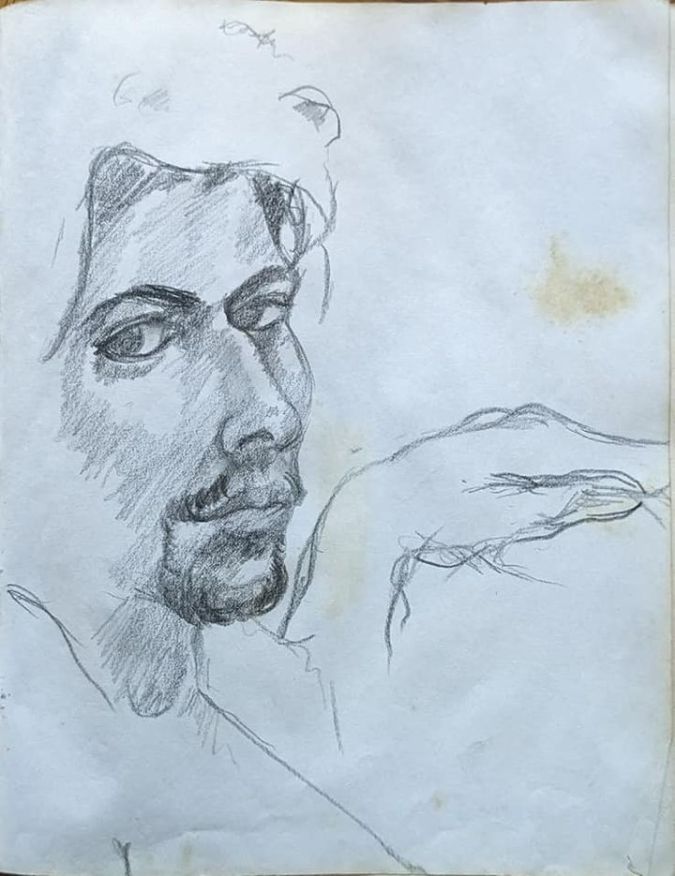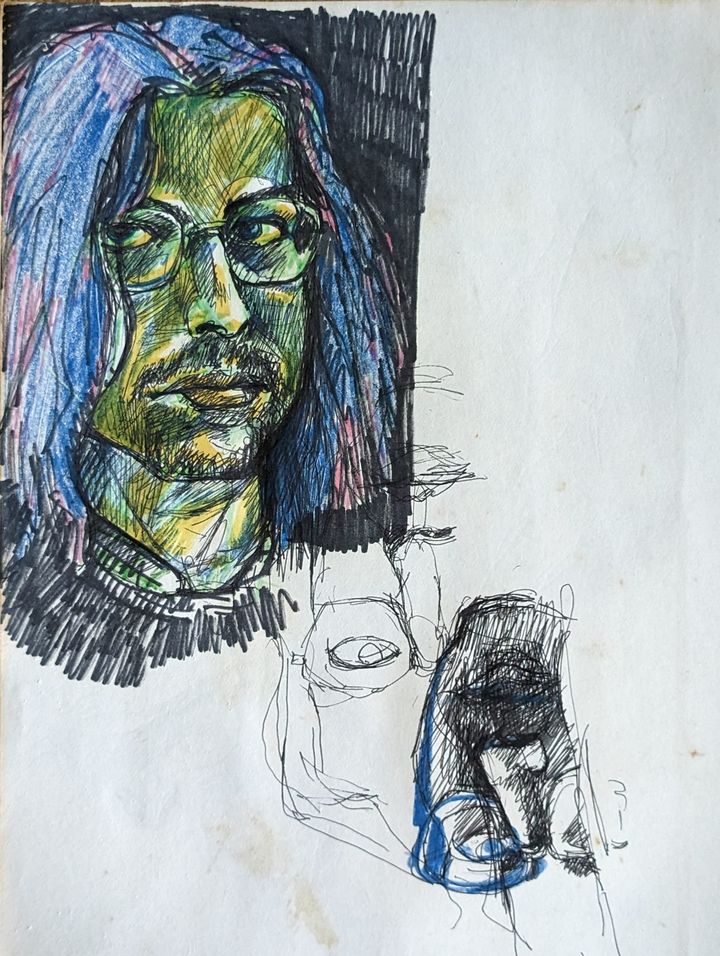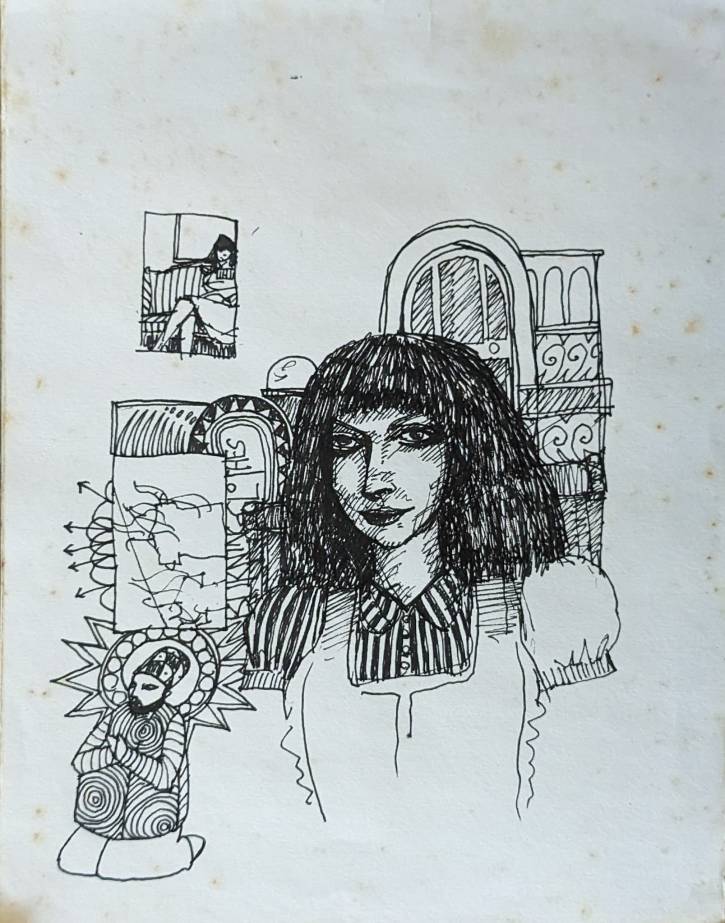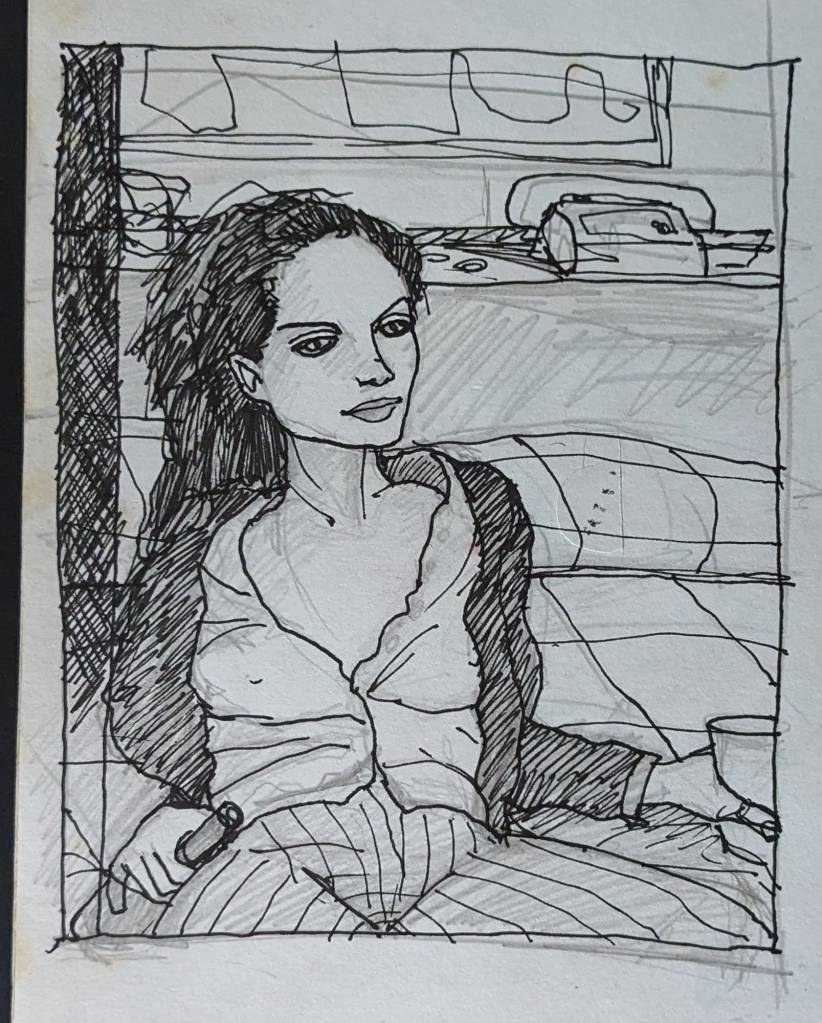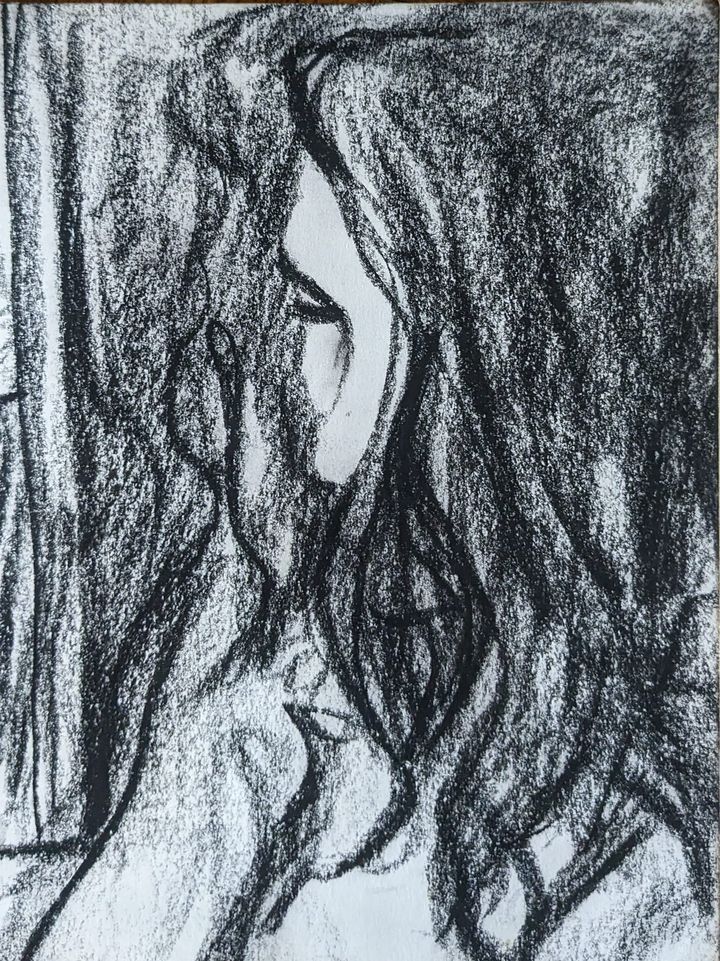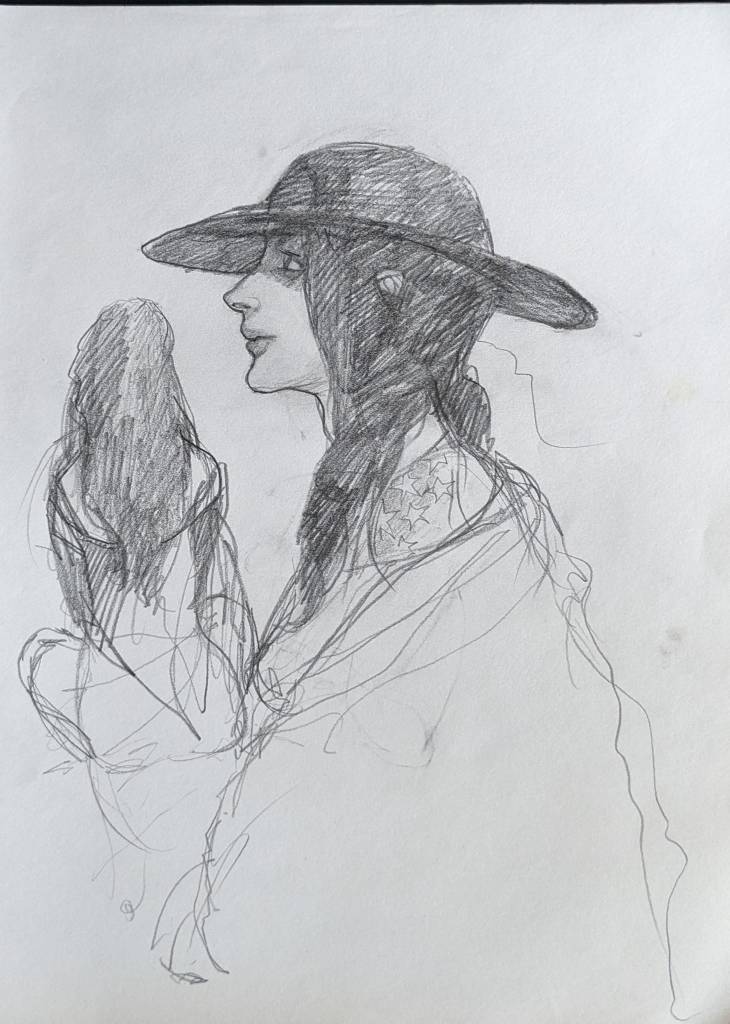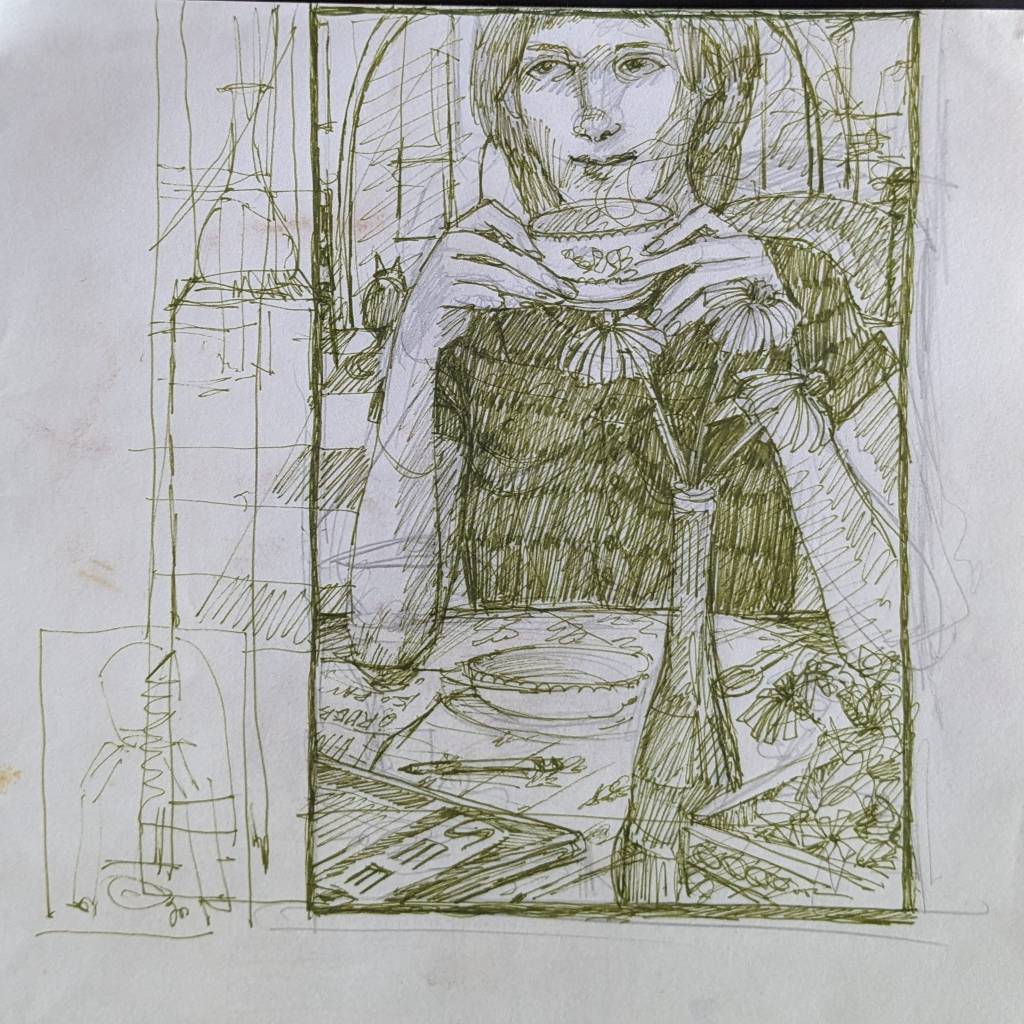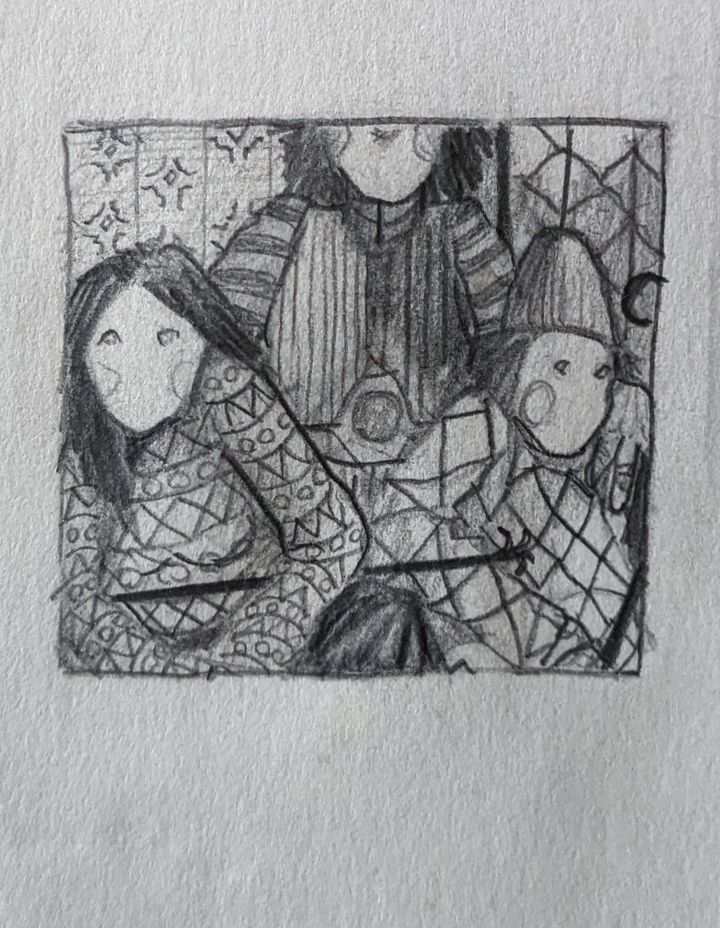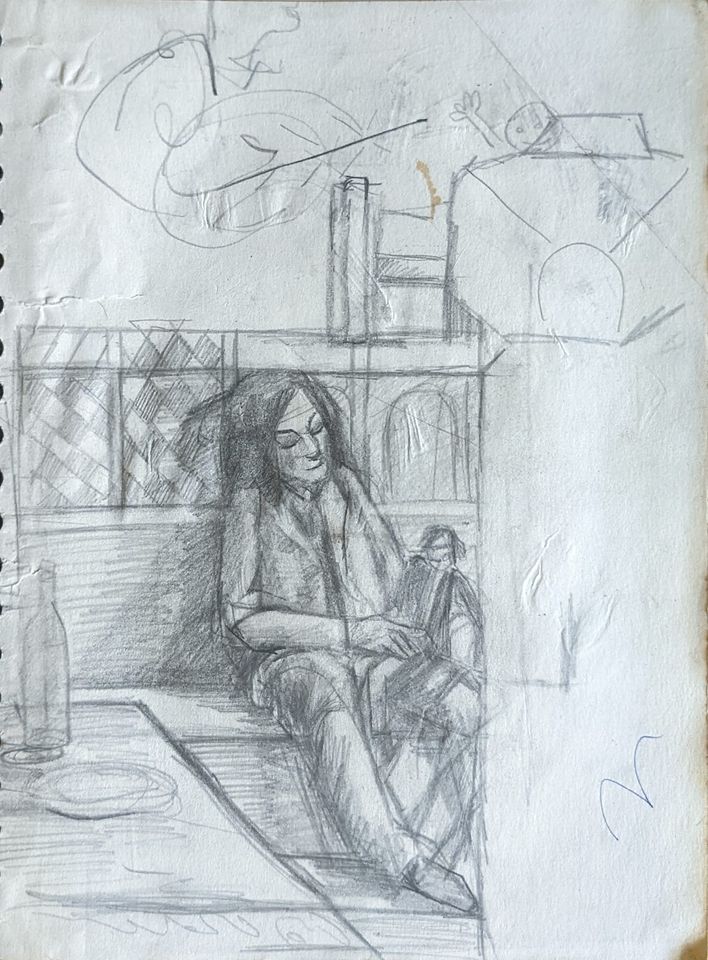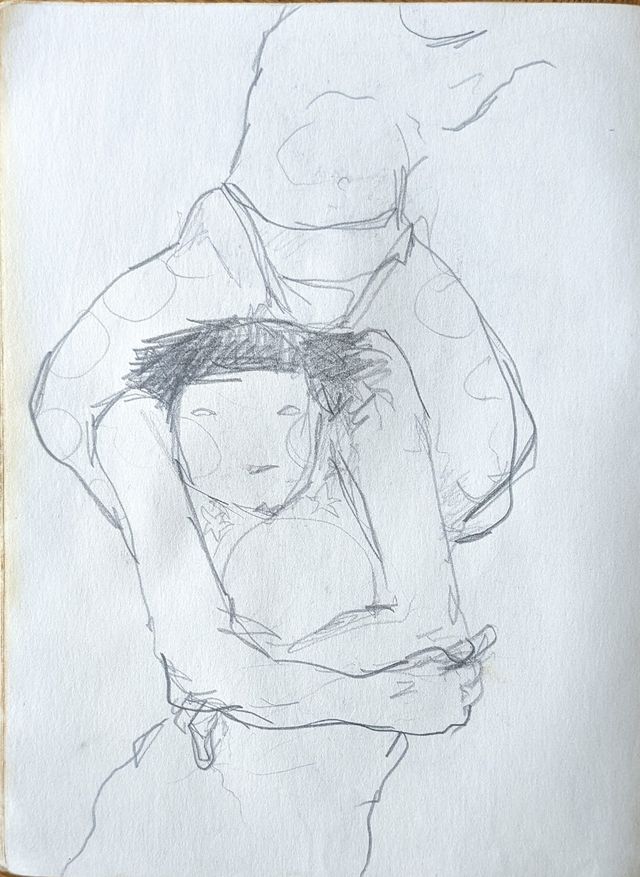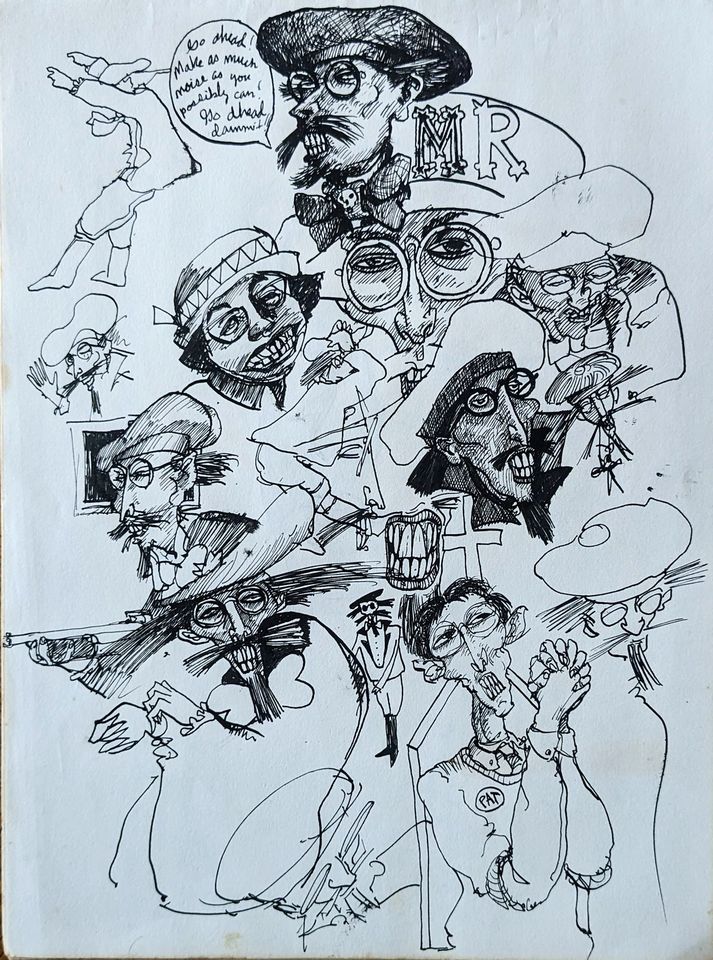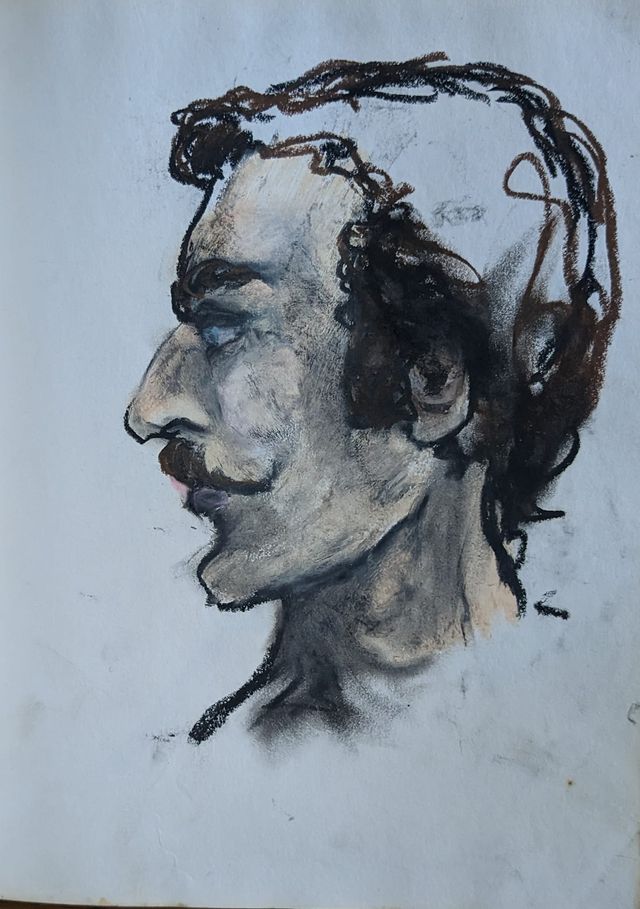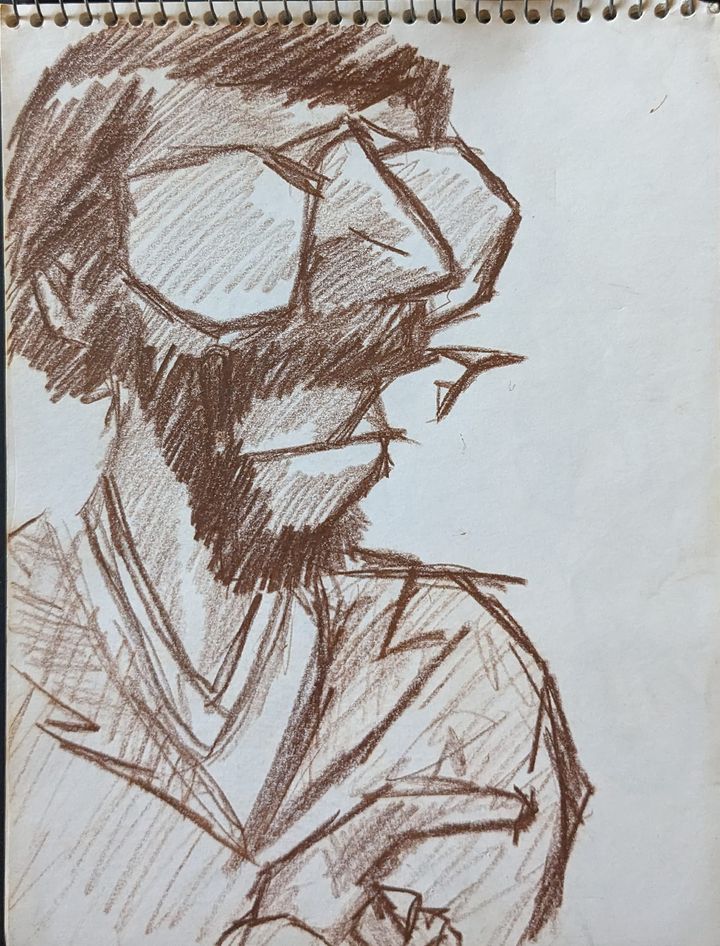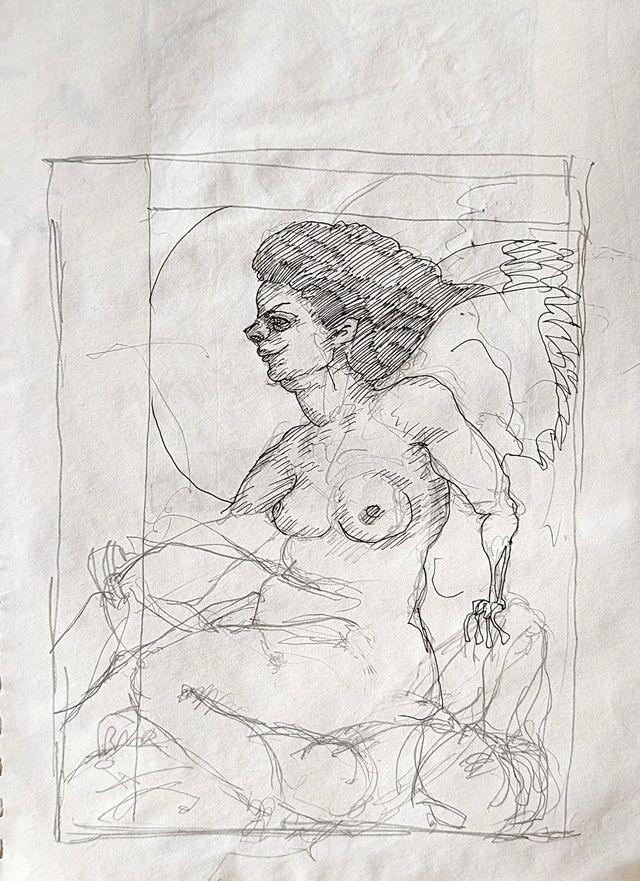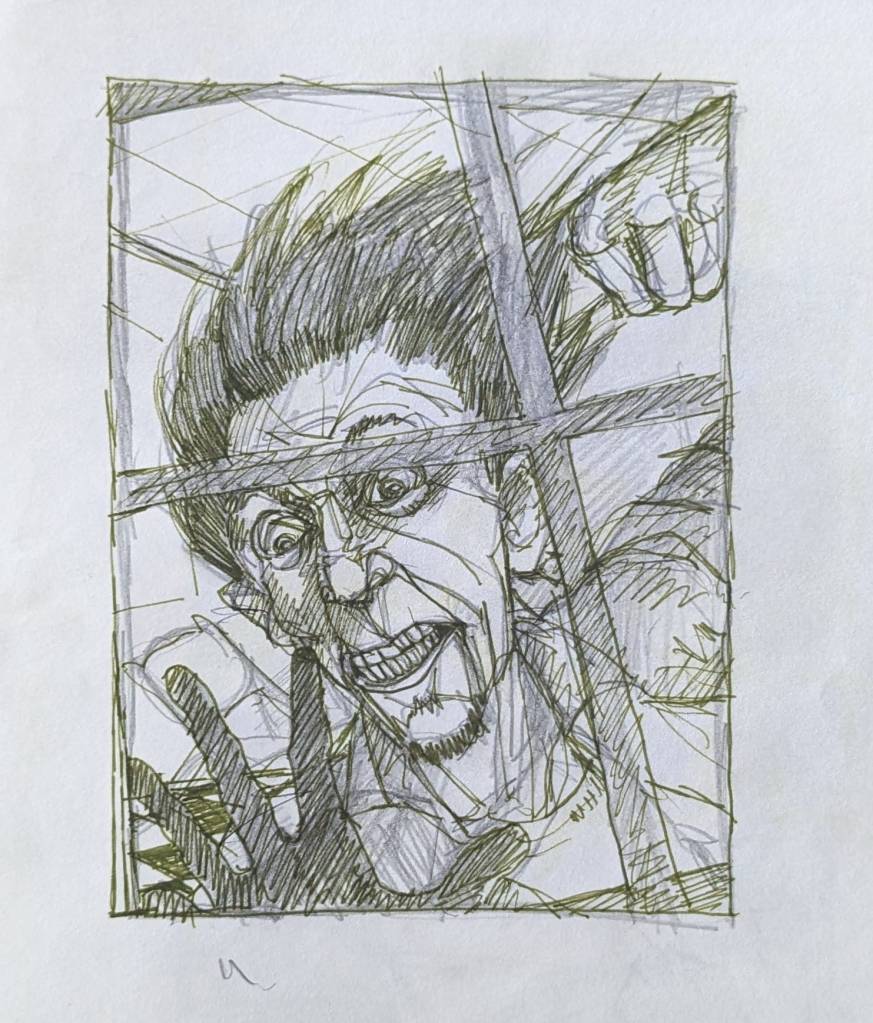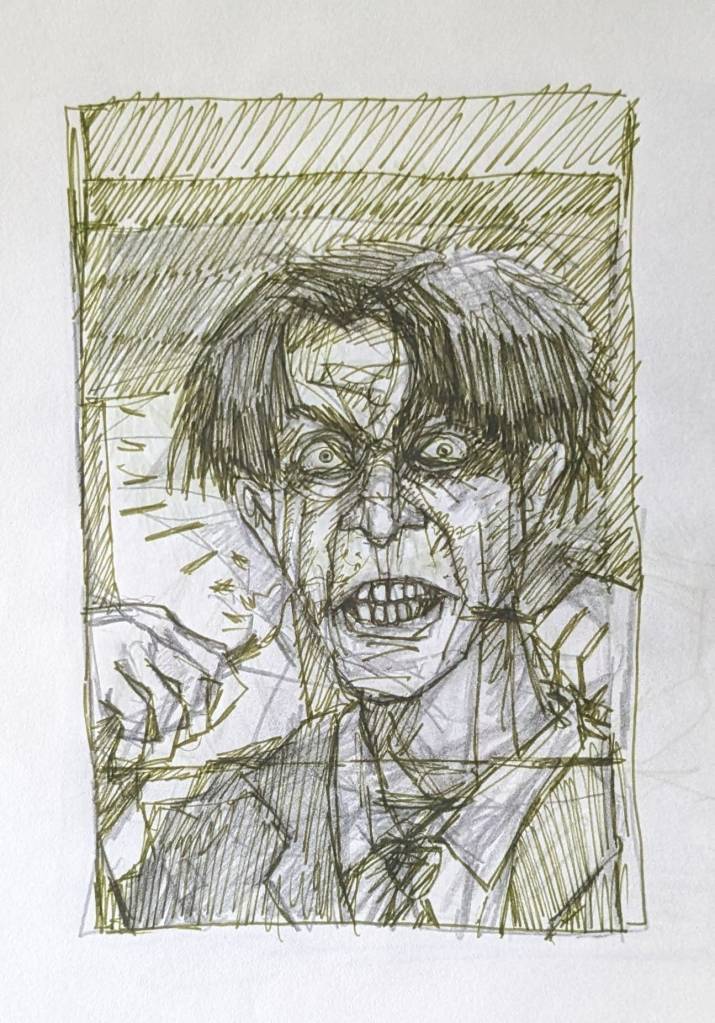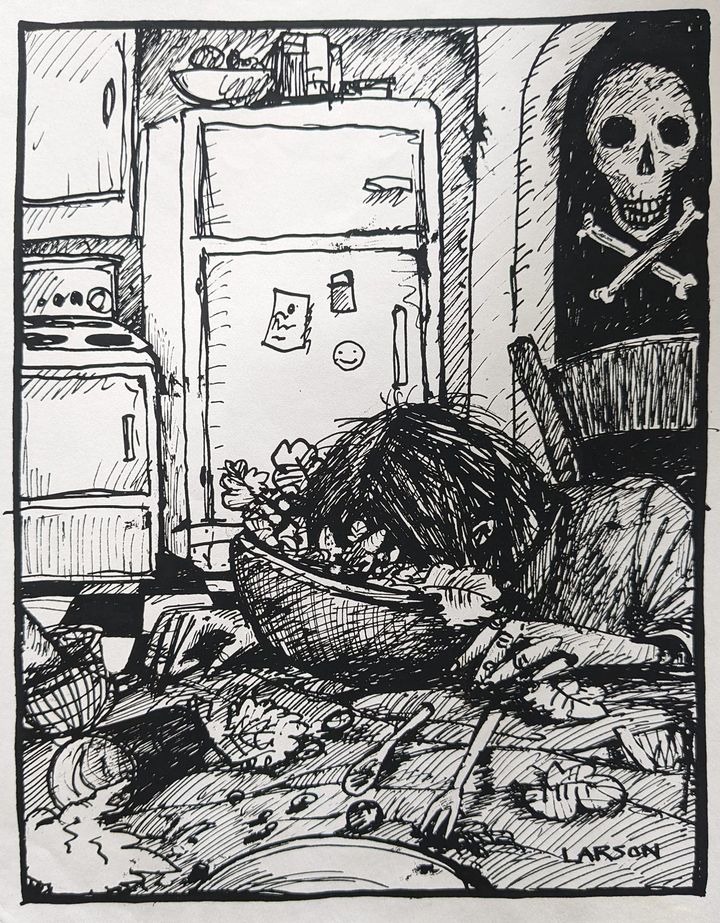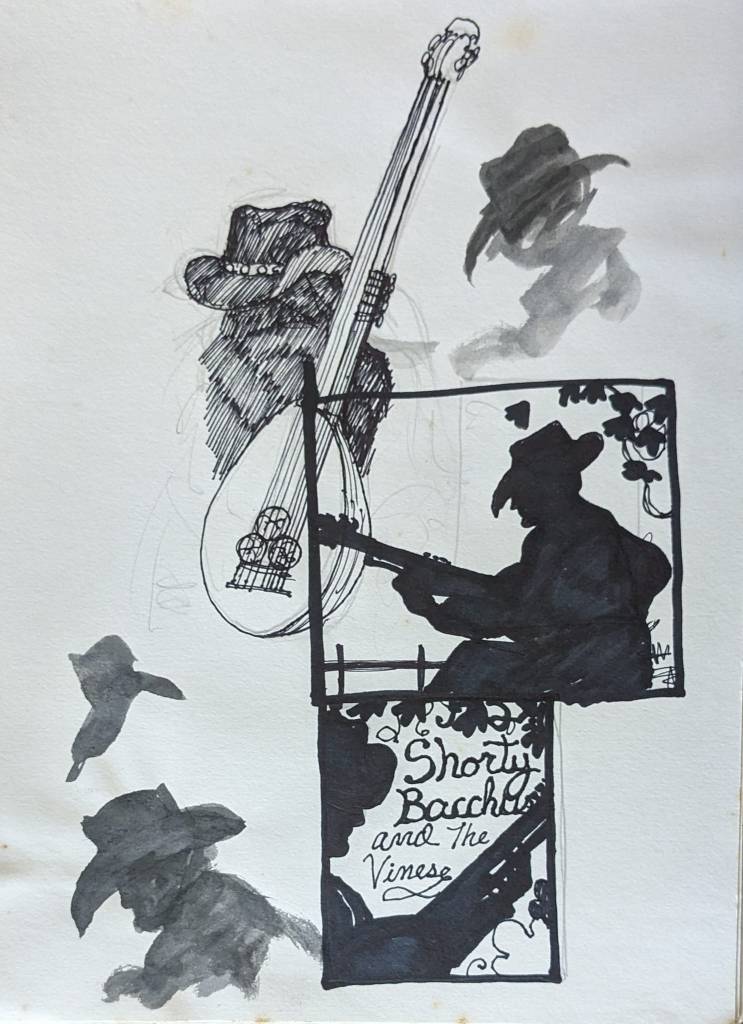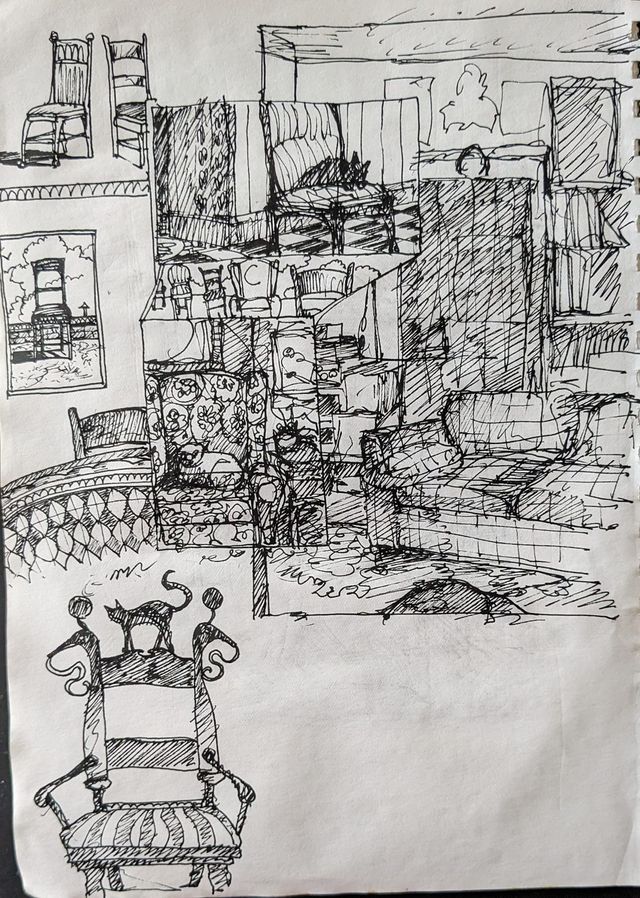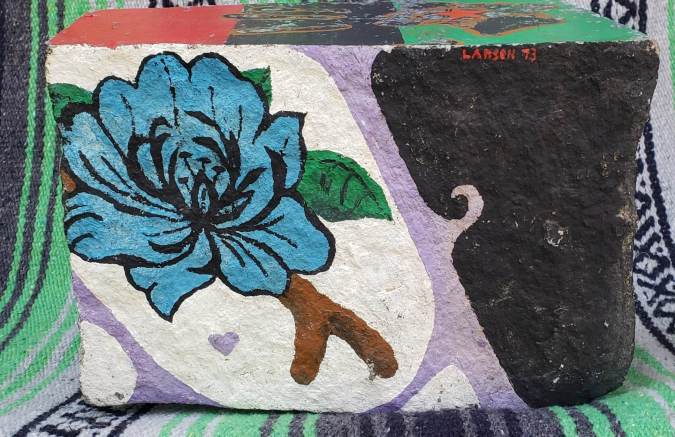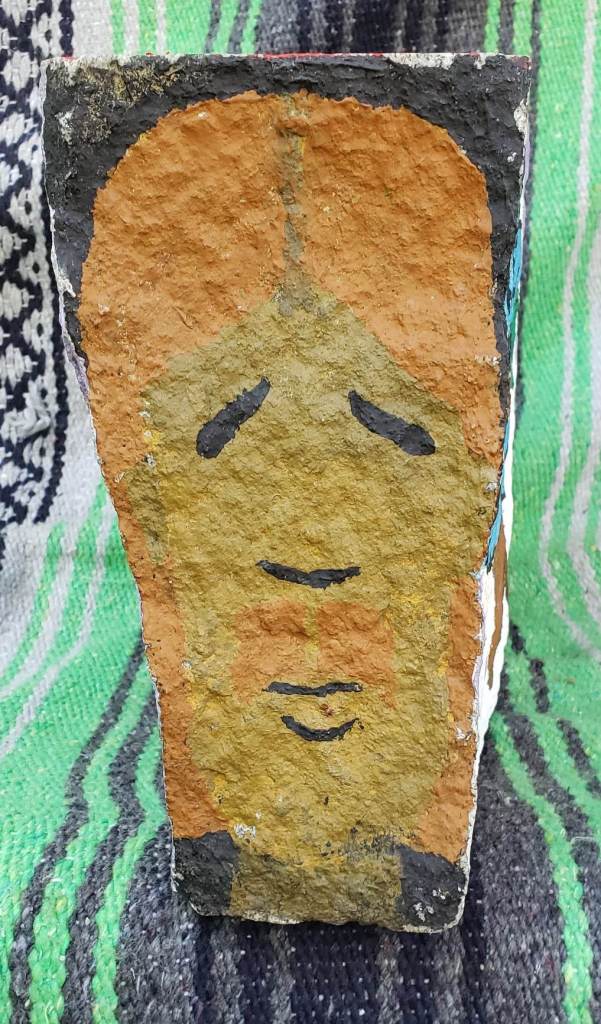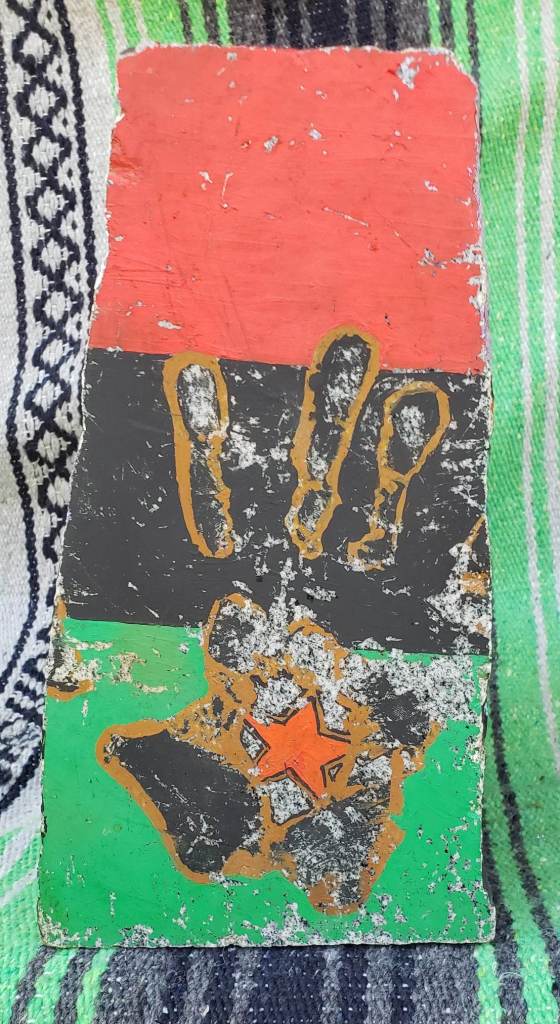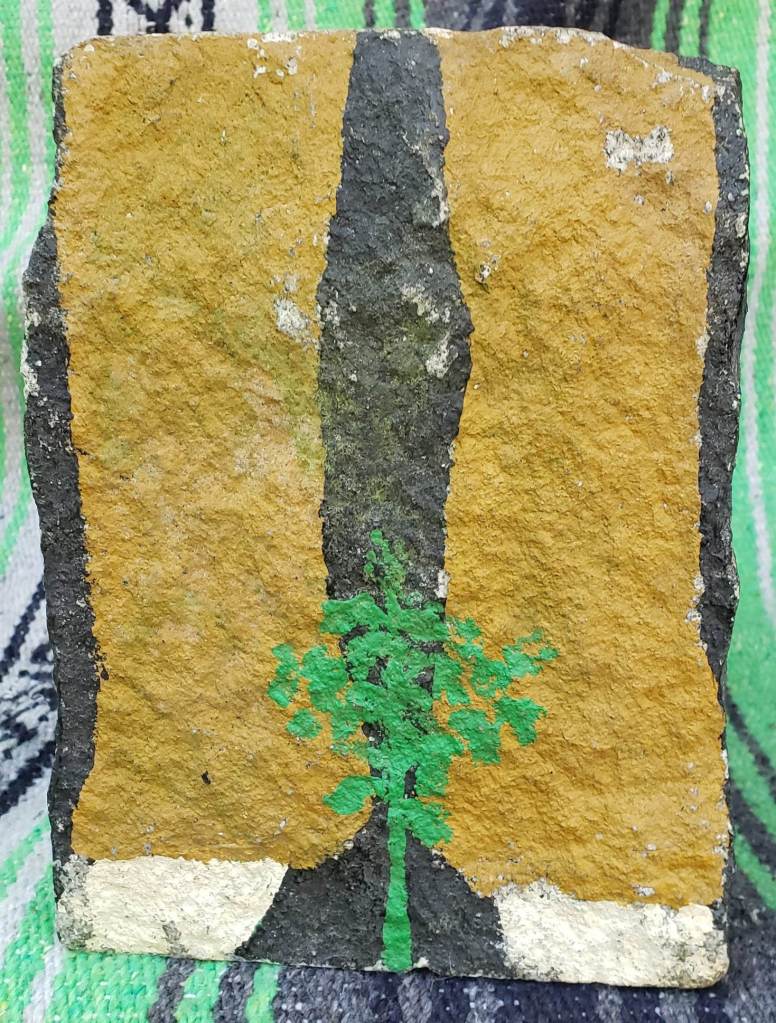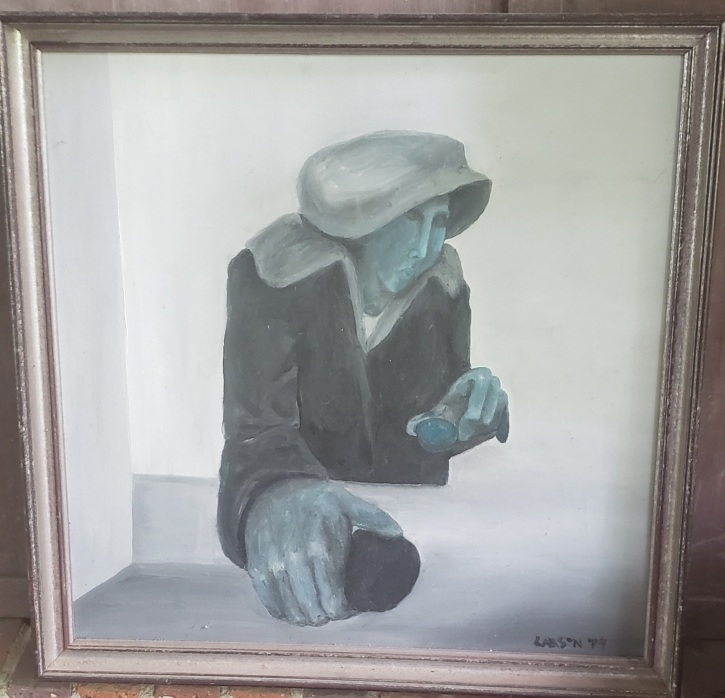Sketchbook Selections and Selfies
Alan B., the de facto steward of David Larson’s artistic estate, has put many hours into going through the pile of David’s notebooks at the Sasser Street home and putting up interesting images on the DEL Art Facebook page. Here is a selection of the best of those, featuring self-portraits, friends, drafts for finished works, the origins of the Duds, and some mighty wild and entertaining ideas.
**************
********************
********************
Marty W.’s David Larson Rock

Painted partially polished granite – 12″ x 8″ x 6″ – 50 pounds plus(?) – Signed and dated “LARSON 73”
Marty W. sent Alan B and i images of a rock David Larson painted. Marty describes it: in 1973 David Early Larson painted this partially polished granite fragment (50 lbs plus!) as a gift to me and Carol (my boys’ mother) making it no doubt his “heaviest” work of art! Some may call it Rock Art, but I prefer Stone Art! David painted all six sides, but the blue rose side has always been the display side.
Marty also sent several images that, like the link for this post, are now to be found on the David Larson Art webpage. Two early works from his career at ECU are shown below. Thanks so much, Marty, and thanks as always to all the Larson art contributors!
David Larson’s Dead Blues Guys & Gals
This page presents bio portraits drawn from photos by David Early Larson. Many derive from stickers given by DEL to Mark Herder and Alan Bowling. Alan published the series on the DEL Facebook page and provided comments on many of the musicians. His description of the process is below.
David researched each figure, finding a photo to xerox, then did a tracing of the face on a clear plastic sheet. He’d xerox that with white backing and drew on the copy. He’d change details and backgrounds before he’d finish the design. Then he’d make multiple copies in the business card size format he wanted, glue them together on a 8×11 sheet and have the stickers printed from the master. Many of those masters are in files he kept. Alan Bowling
One of the most important interpreters and writers of folk blues who was pardoned from prison for his expertise. The Library of Congress hired him to record many old songs for their archives accompanied by his 12 string guitar. “The Gallis (Gallows) Pole”, “In The Pines(Where Did You Sleep Last Night?)”, “Goodnight Irene”, and “Black Betty” are among them.
McKinley Morganfield (April 4, 1913 – April 30, 1983) known professionally as Muddy Waters. Migrated from Mississippi to Illinois to become one of the leaders in Chicago electric blues.
Born Eleanora Fagan in 1915 in Philadelphia from an unwed couple, Billie Holiday grew up in Baltimore with her mother. A troubled early life led to cleaning a brothel where she heard records by Bessie Smith and Louis Armstrong. She started singing, adapting her musician father’s name Halliday and copying the way the instruments phrases sounded with her voice. She was singing in clubs when she was heard by John Hammond who said she was the first female singer “who actually sounded like an improvising jazz genius”. He got her with pianist and Benny Goodman collaborator Teddy Wilson to record for Brunswick. “What A Little Moonlight Can Do” and “I’ll Cry For You” were instant hits.
Another accompanist was Lester Young who played tenor sax for Count Basie. “Prez” was thought to be her love interest for many years and gave her the nickname Lady Day. Billie met Ella Fitzgerald who was the singer in Chick Webb’s band and they had a contest, Basie’s band backing Billie at the Savoy in January 1938. Metronome magazine claimed Ella won, but Downbeat said the opposite.
By March, she was singing for Artie Shaw, but had to deal with being the only black member of the band, entering kitchen doors and service elevators to the stage. This became too much for her, so she moved on.
“Strange Fruit” was so controversial, she had to go to a small label, Commodore, to record it. Her original performance of it in a club had the waiters silence the crowd while the house lights were darkened with a spotlight on her head. She disappeared directly afterwards.
Ma Rainey was the Mother of the Blues and was a tough bandleader in the 1920s whose life has been depicted in film.
One of David’s favorite bluesmen, Lightnin’ Hopkins. Known to work for cash in the recording studio, he could knock out an album in an afternoon, improvising and making a song up on the fly using bits from old songs. He made sides for different labels over the years, never worried about the rights to any of them.”Mojo Hand” and “Mr. Charlie” were ones he was known for, but his solo work was his best. Big Boy Henry told me once that he thought Hopkins was the best blues singer/ guitarist in the business. David had a videotape we’d watch of Hopkins hanging out at a ranch in Texas, talking and doing songs.

Only three photographs exist of the most famous Delta blues artist who had two recording sessions in hotel rooms in Texas in ’36 & ’37 producing 29 classic songs. “Love In Vain” and “Stop Breaking Down” were covered by the Stones and “Crossroads” by Cream. “Sweet Home Chicago”, “Red Hot”, and “Hellhound On My Trail” are among others that have been covered.
Keith Richards first met Mick Jagger carrying a copy of an album of Johnson’s singles and couldn’t believe there was only one person playing guitar on those songs. Story goes Johnson sold his soul to the devil at the crossroads of highways 49 and 61 in Clarksdale, Mississippi to be able to play so well.
Sadly Johnson was murdered by a jealous bartender that slipped poison into his whiskey bottle.
Cotten (whose name was misspelled) played left handed in her Carolina Piedmont cotton picking way.
From New Orleans, Morton has the recognition of being the first arranger of jazz, proving that a music built on improvisation could still “retain it’s essential characteristics when notated” (Wiki). His recordings with the Red Hot Peppers sound as fresh as they did in the 1920s. He claimed to have invented jazz in 1902 and had his first composition, “Jelly Roll Blues” published in 1915. Pianist, band leader and composer, he exaggerated his worth to many and lost credibility in his later years, when his accomplishments spoke for themselves.

The Queen of the blues needs no introduction, but I favor her recordings with Louis Armstrong. (Alan B)
Mathis James Reed was described by critic Cub Koda as “perhaps the most popular influential bluesman of all” because of his easy going electric style. Many covered his songs including Elvis Presley, Rolling Stones, and Van Morrison’s band, Them. Born in Mississippi, he was trained on guitar and harmonica and played with Eddie Taylor for a spell before relocating to Chicago in 1943. Reed was drafted in the Navy and served in WW II. When discharged he returned to MS to be married, then took his wife to Gary Indiana to work in a meat packing plant. He relocated again to Chicago and tried to get a contract with Chess, but was turned down. He landed one with Vee Jay and with Eddie Taylor again, his hits started rolling. With wife Mary singing back-up, “You Don’t Have To Go”, “Bright Lights, Big City”, “Baby, What You Want Me To Do”, and “Big Boss Man” are among his biggest songs.
Reed’s rampant alcoholism became so bad Mary would have to remind him of his lyrics when performing. Misdiagnosed epilepsy set in during 1957. Vee Jay closed and he moved to ABC- Bluesway, but never had a hit. In 1968 he toured Europe with the American Folk Blues Festival with other big names. Reed died in 1976 in CA, eight days before his 51st birthday. He’s been inducted into the Blues Hall of Fame and R&R Hall of Fame

Larger than life with a voice to match, Mable Louise Smith could belt out some jump blues. She recorded “Whole Lotta Shakin’ Going On” produced by Quincy Jones two years before Jerry Lee Lewis did his version. He was so influenced by her take that he upped his act to follow her lead to be more raunchy and raucous. Her 1956 hit “Candy” won a Hall of Fame Grammy in 1999, but it’s pretty tame compared to most of her output. Big Maybelle is seen performing “All Night Long/ Ain’t Mad At You” in the film of the 1958 Newport Jazz Festival: Jazz On A Summer’s Day . Her last hit single was a 1967 cover of ? And The Mysterians’ “96 Tears”.

Pink Anderson was born in Laurens, SC and lived and played in nearby Spartanburg, SC most of his life. Another Piedmont style artist, his late 1920s and ’30s recordings were few until the mid 1950s when in bad health, attention was brought to him and he recorded one album in the early ’60s and appeared in a documentary film.
Valerie Wellington started in the 1980s as an opera singer and played Ma Rainey in a stage production while in her 20s. She caught the blues bug and went on to use her bellowing voice in blues standards for Alligator records.
Frankie Lee Sims was a cousin of Lightning Hopkins who released nine singles and worked as a guitarist for T-Bone Walker and King Curtis among others.
Alberta Hunter had been working as a nurse for 20 years before John Hammond got her back in the studio after a few engagements she did in NYC. “Amtrak Blues” was her comeback album in 1980.
Melvin “Lil’ Son” Jackson was a contemporary of Lightning Hopkins who was a mechanic before pursuing his music career. His “Freedom Train Blues” was a national hit along with “Rock Me Baby”. After injuring his arm he went back to his first profession.
Wallace wrote over 40 songs with her brothers to record for Okeh records early on with big names of the day backing her including Louis Armstrong. She resumed her career in the 1960s and was awarded a Grammy in 1982.
Richard Trice was a Piedmont blues singer/ guitarist who never left his native central NC. He and Brother Willie befriended Blind Boy Fuller who helped them get into recording, backing him and doing their own songs backing each other.
As Rich Trice, he recorded “Come On Baby” and “Trembling Bed Spring Blues”. As Little Boy Fuller he recorded a number of songs for Savoy, but only “Shake Your Stuff” and “Lazy Bug Blues” were released. He later gave up the blues to join a gospel group.
These brothers played with Blind Boy Fuller. “Willie” is the correct spelling. Both played in the Piedmont Blues style.
Fuller was from Wadesboro, NC and played around Chapel Hill and Durham. He was the most popular Piedmont blues artist of the day. On a later album of sides he listed Pink Anderson as someone he’d played with along with Floyd Council. Sid Barrett had that album and picked the first names of those two bluesmen for his band’s name.
Broonzy was born in 1903 in either Mississippi or Arkansas as one of 17 children from the same parents. The year has been disputed. At 10, he made a fiddle he could play with his uncle doing spirituals at gatherings. His army recruitment has also been scrutinized, but we know he relocated to Chicago in 1920. After giving up the violin, he picked up guitar, learning from minstrel show performer Papa Charlie Jackon. He played in clubs into the 1930s, changing from country to blues and wrote his first instrumental, “Saturday Night Rub”.
When Robert Johnson died, his place in “From Spirituals To Swing” show at Carnegie Hall in 1938 was filled by Broonzy. (For Johnson’s part a victrola was put on stage and the records “Preachin’ Blues” and “Walkin’ Blues”were played to the audience)
Recordings followed on Paramount and Bluebird. By 1940 a song was recorded by Charlie Segar that when Broonzy recorded his version in 1941, it became the standard arrangement. “Key To The Highway” was a hit and was later covered many times. Broonzy became part of the Folk scene that traveled to Europe in the 1950s and eventually went worldwide. He was a huge influence to the later skiffle movement musicians in Britain including John Lennon. Back home after an outdoor gig with Pete Seeger that was broadcast, he became a teacher at the Old Town School of Folk Music in 1956. He died in 1958 from throat cancer.
Most know Memphis Minnie’s song “When The Levee Breaks”, a true story her husband Kansas Joe McCoy and she recorded in 1929 about the great Mississippi flood of 1927. Minnie was a 12-string guitarist who recorded many sides on her own.
A cousin of John Lee Hooker, and protege of Robert Nighthawk, Jr., Earl was considered the “blues guitarist’s guitarist”, known for his slide work, sometimes on a double neck. His best known original instrumental is “Blue Guitar”. He played with many including Junior Wells on ” Messin’ With The Kid” and Muddy Waters on “You Need Love” and “You Shook Me” (first one used by Led Zeppelin for “Whole Lotta Love”, second covered by them and Jeff Beck) He took to the road with his Roadmasters band, sometimes without a booking, hoping to land a gig wherever he landed. B.B.King listed him as one his top 10 favorite guitarists.
Born in Grenada County, Mississippi in 1936, Samuel Gene Maghett relocated to Chicago in 1956 and was given his moniker by his friend and bass player. He recorded for Cobra records from 1957-’59 where bassist/songwriter and producer Willie Dixon moonlighted from Chess. Dixon praised him for his unique guitar style and high voice that was unmistakable. “All Your Love” and “Easy Baby” were his most known tunes. After spending six months in prison for desertion from the draft, his “Feeling Good (Gonna Boogie)” became a hit. He signed with Delmark records in 1967 and toured internationally with harpist Charlie Musselwhite. His big breakthrough was at the Ann Arbor Blues Festival in 1969, but he didn’t make it to the end of the year, dying from a heart attack in December.
From a musical family, Luther Tucker was a protege of, as he called him, “Mr. Robert Lockwood, Jr.” who taught him minor and diminished chords to play rhythm guitar behind him. Lockwood became his guardian while he was 16, so he could go on the road. He learned to read music and even played bass strings on a tuned down guitar before the Fender bass was invented. They backed Sonny Boy Williamson II, Little Walter, and did classic sides by Muddy Waters, Howling’ Wolf and others.Tucker moved to the west coast in the late ’60s to play with the James Cotton band. Then he did a residence in Austin, TX with John Lee Hooker’s band and started The Luther Tucker Band, singing and playing blues and soul. He moved to San Francisco and played clubs there through the ’70s. He only recorded two albums, one incomplete, before dying at 57. His body was shipped to Chicago and buried in an unmarked grave until a benefit concert was held for a headstone.
John Hurt, from Mississippi, made recordings in the late 1920s that never got the recognition they deserved until he was resurrected in the early 1960s with the folk movement. He recorded songs he’d done in the past and others in his home with great clarity that brought him new fame in his later years.

Both of these slide guitarists were known for their approach. Hudson Whittaker aka Tampa Red had a single string slide style. Theodore Roosevelt “Hound Dog” Taylor played a cheap Japanese Tiesco del Ray guitar, wearing a metal slide on the fifth finger on his six fingered hand. (See comments for a picture of his left hand, both had six fingers)
While Red was more precise, Taylor was loud and crowd pleasing with his danceable band The Houserockers. He loved being around people as his nickname suggests.
Blind Lemon Jefferson (Lemon Henry Jefferson) was born blind in Loutchman, Texas in 1893 and became regarded as one of the most popular blues and gospel singers of the 1920s. He was called the Father of the Texas Blues. He had a unique style with a high voice that had younger blues artists refrain from copying because it was hard to imitate.
As a street musician, he played in East Texas towns on street corners til 4am. He met Leadbelly in the early 1910s in Dallas developing in the Deep Ellum section there. He then met T-Bone Walker in 1917 and taught him some basics on the guitar in exchange for services as a guide.He was taken to Chicago to enter the recording world in December 1925. His first sides were gospel, but his second session produced the hits, “Booster Blues” and “Dry Southern Blues”. Overall he recorded about 100 songs, mostly on Paramount, and most in poor quality. In 1926 he re-recorded those two songs with better equipment. When he moved to Okeh the next year and put out “Matchbook Blues” and “Black Snake Moan” on the flip side, it became a hit, but he had to return to Paramount under contract. Soon “See That My Grave Is Kept Clean” became a hit.
Jefferson’s death has different stories. One was a jealous lover poisoned his coffee, another said he had a heart attack while being attacked by a dog, still another had him killed and robbed of his royalty check by his guide at the train station in Chicago. Most likely he had a heart attack during a snow storm that left him disoriented in December 1929. His body was shipped back to Texas and put in an unmarked grave until 1967 when a historical marker was erected. Since 2007, the area has been renamed after him and has been kept tidy.
Gatemouth Brown played fiddle and a leather pick guarded Fender Esquire electric guitar with his long fingers. A bit of western swing thrown into his style. I saw him at JJ’s in Greenville in the early 1980s. My girlfriend presented him with a freshly picked bouquet of flowers. Brown proceeded to remove the rings from his hand before humbly accepting the gift. (Alan B)

The Singing Brakeman or Blue Yodeler, also known as The Father Of Country Music. David misspelled his last name, leaving out the “d” in Rodgers. A popular recording artist, he developed tuberculosis at the age of 27, but kept going until it got difficult to perform. Shows were cancelled and he had to sit and then lay down to record his last sides. He collapsed on a street and passed at the age of 35 in 1933.
Otis Rush played guitar left-handed, but strung his strings as a right handed player would and curled his little finger of his picking hand under the low E string that was at the bottom instead of the top. He got a certain sound that way, reminiscent of Magic Sam and Buddy Guy, called West Side Chicago Blues.
Born in Mississippi in 1934, he relocated to Chicago where his first big hits were on Cobra records, penned by Willie Dixon.
“I Can’t Quit You, Baby”(covered by Led Zeppelin) became his signature song in 1956. “All My Love” and “Double Trouble” followed. After Cobra closed in 1959, he tried other labels with sides here and there like Chess, Duke, and Vanguard.
In 1969 he released “Mourning In The Morning” on Cotillion with help from Mike Bloomfield and Nick Gravenites, using the FAME studio in Muscle Shoals, AL doing a mixture of blues, rock, and soul.
In 1971 he recorded an album in San Francisco for Capitol, but it wasn’t released until he bought the masters and put it out on a small Japanese label in 1976. Bullfrog Records picked it up in the US and it’s considered one of his best: “Right Place, Wrong Time”. After a stint at Delmark in the ’70s, he retired for awhile.
His comeback in 1985 was a live album from the San Francisco Blues Festival, “Tops”. His first studio albums in 16 years, “Ain’t Enough Coming”, and “Any Place I’m Going” landed him a Grammy for Best Traditional Blues in 1999. He stopped recording except being included on a few tribute albums and a few festivals. He was honored at the 2016 Chicago Blues Festival, but he was too ill to perform.
One of the original Delta blues artists who taught a young Howlin’ Wolf some guitar chords.
Stickers & the DEL Commie File
Larson loved to “publish” his small b/w sketches, especially bio pics, decorated panels, and Muerto Dia images. As Alan B has described, he would mount these on the backs of road signs and other likely spots around town. He also gave many away and they are now tiny treasures for those that saved them.
The DEL Commie File
Send your sticker images to JDJ or the DEL Facebook page!
David Larson: Dead Dads, Lt Walsh & Karl
The Dead Dad’s Club, Lt Walsh Day, the Poker Game, the Kentucky Derby Mint Julep Party, all were a big part of David’s social life and the action often involved brother Karl and his house on Sasser Street in the Oakdale neighborhood of Raleigh. And David always celebrated not just with drinking but with art.
The Dead Dad’s Club was invented by Karl Larson. David went through training and qualified to make videos for broadcast on Channel 10, Raleigh’s public access station. His video starring Karl and others about the club was banned from broadcast for lewdness ( the urination of Peter E off camera during the filming) but represents an excellent history of the event. Alan B posted the video here.
The annual party was attended only by people who had lost their Dad. David’s Dad died at age 50 (David told friends he thought he would die at the same age). David made a card for some of the occasions.








**************
Lt Walsh was a Confederate soldier who, perhaps in a drunken angry mood, fired on the delegation of Union officers entering Raleigh to accept the city’s surrender. He was captured and hung at a spot in Oakwood near the Side Street Cafe. His grave is prominent in Oakwood Cemetery, and Karl Larson, a fervent local historian, made adorning his grave a special and sometimes large event every April 13th for over 25 years. David’s portrait was used in the elaborate brochure made for year nineteen.
***********
Karl Larson was a Raleigh legend in his own right and he as well as his hospitable house on Sasser were an important part of David’s life. Karl’s unique take on history was evidenced as far back as high school, when Steve, my classmate, would intimate stories of midnight readings of Poe in City Cemetery. A few years later, he made his claim to fame with an elaborate, well documented funeral for the original Boylan Avenue Bridge, which was torn down amid concerns for the continued existence of Boylan Heights as downtown and its throughways grew. He is seen below with Kathryn Myers at the ceremony.
Karl had a fine career as graphic designer and publication manager at NCSU, but his reverence for local history blossomed late in life with a post-retirement job as archivist for the state and especially with his magnificent accomplishment in leading the effort to restore Joe Cox’s Light Wall on the side of the NCSU Library. He also became a beloved part of a local scene blog call Goodnight, Raleigh.
“Raleigh Boy” posts on Goodnight, Raleigh
Karl’s M.A. thesis on the history of Segregation in Raleigh
Remembering the Man Who Remembered Raleigh
BY NED BARNETT
************
David Larson survived Karl and his brother Steve, but not by much and now Phil Larson is left with the loss of all three brothers in a few short years. Steve’s dog Dup was a favorite subject for David, and below are some images contributed by some of the many people who have shared their art on these posts. Thanks to all, and love you some DEL!

